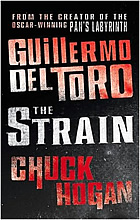BOOK REVIEW:
Many
will be familiar with Guillermo del Toro as the director of
“The Devil’s Backbone”, “Hellboy”
and “Pan’s Labyrinth”, but few would have
heard of del Toro as the writer. “The Strain”
is del Toro’s maiden writing venture, (co-authoring
with Chuck Hogan of the acclaimed novel “Prince of Thieves”)
and it is one riveting read from start to finish- indeed,
it is one of the most gripping pieces of apocalyptic fiction
this reviewer has ever read.
The book
begins dramatically with a Boeing 777 stopping dead on the
tarmac of JFK International Airport, New York shortly after
landing. The whole plane goes dark, no radio communication
seems to work and most significantly, there is not a sound
to be heard from inside the aircraft. When rescue workers
finally gain access, they find everyone on the plane dead,
save for four passengers. Modern-day science behoves that
“epidemic” be the only rational explanation, and
thus the Centre for Disease Control (CDC) to be called in.
Thus del
Toro introduces us to our first protagonist, Dr Ephraim Goodweather,
head of the CDC’s New York team. Dr Goodweather is also
separated from his wife, fighting for custody for their son-
this familial side to the character achieving much emotional
resonance towards the end of the book. The other protagonist
is Abraham Setrakian, an elderly Armenian professor who runs
a pawnshop in New York and understands immediately the extent
of the threat facing New York City.
If you,
like this reviewer, dives in knowing little of the book, you
would think that there’d be some kind of super-virus,
a very powerful strain much like that in “Resident Evil”
or “28 Days Later”. In this case, ignorance is
quite simply bliss, for the less you know about how things
would unfold the better- that way, when Setrakian reveals
to a skeptical Eph what creature is really upon them, you’d
be able to identify much much more closely with Eph.
The pleasure
here is really twofold- first, the discovery of the truth
and second, the unfurling of del Toro and Hogan’s prose.
It’s clear that del Toro’s rich eye for detail
that made his films such a visual delight is just as hard
at work here, for every scene in the book unfolds meticulously.
“The Strain” isn’t only interested in telling
its story, it also wants to make sure that you can imagine,
that you can picture everything as it is told, so every setting
in the book is painted and described vividly for the reader.
Those
familiar with the ins and outs of New York will certainly
have the added pleasure of identifying the various landmarks
in the city in which the book’s action takes place.
One also can’t help but recall one of del Toro’s
earlier films, “Mimic”, a horror-thriller where
a mutant breed of cockroaches was infesting Manhattan and
entomologists had to go deep into Manhattan’s subways
to hunt them down. A good part of the action in “The
Strain” also takes place in New York’s labyrinth
of underground tunnels, which makes for an even more intriguing
adventure.
It’s
also worthy to note that “The Strain” is the first
in a planned trilogy, with the next instalment due the middle
of this year- and hence the epilogue at the end of the book
(which this reviewer promises will take the story up to an
entirely higher notch). Yes, “The Strain” is only
the beginning, and what a sturdy beginning it is, a thriller
relentless paced from start to end and an apocalyptic fantasy
you won’t soon forget.
CHOICE XCERPT:
"Eph entered first. The stillness was palpable. Nora
followed, standing with him shoulder to shoulder at the head
of the middle cabin.
Seated corpses faced them, in row after tow. Eph’s and
Nora’s flashlight beams registered dully in the dead
jewels of their open eyes.
No nosebleeds. No bulging eyes or bloated, mottled skin. No
foaming or bloody discharge about the mouth. Everyone in his
or her seat, no sign of panic or struggle. Arms hanging loose
into the aisle or else sagged in laps. No evident trauma.
Mobile phones- in laps, pockets and muffled inside carry-on
bags- emitted waiting message beeps or else rang anew, the
peppy tones overlapping., These were the only sounds."
VERDICT:
    
Review
by Gabriel Chong
|

